Wai-Fah Chen.The Civil Engineering Handbook
Подождите немного. Документ загружается.

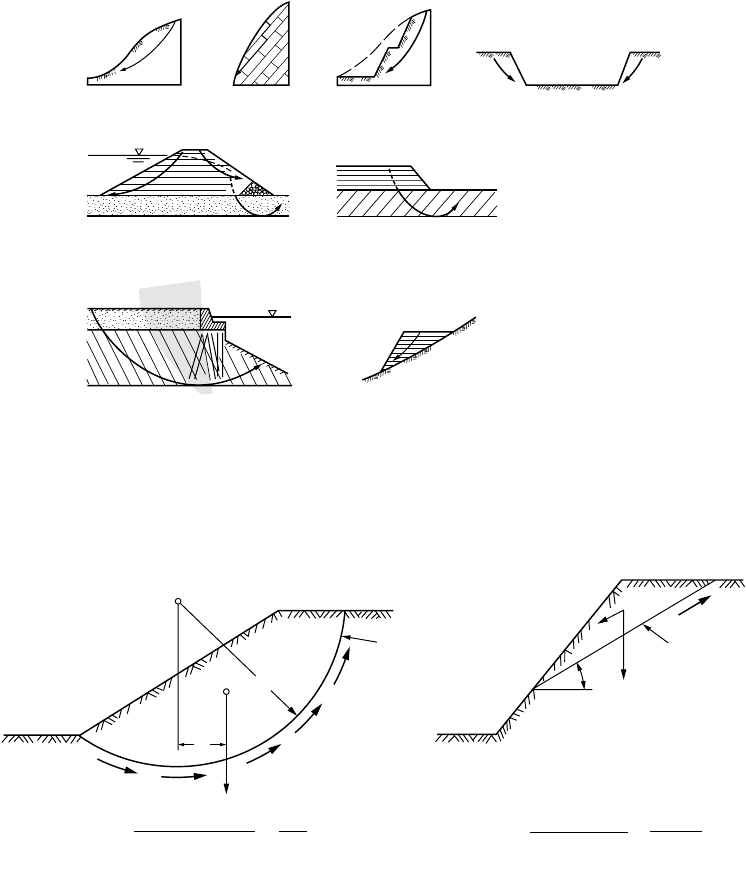
21
-2
The Civil Engineering Handbook, Second Edition
Limit equilibrium methods of analysis typically use the Mohr–Coulomb failure criterion, in which
(see Table 21.1)
where
s
is the shearing resistance,
c
is the cohesion,
s
n
is the normal stress, and
f
is the angle of internal
friction. Appropriate total stress or effective stress strength parameters for specific loading conditions are
provided in Table 21.2.
The factor of safety has been expressed in a number of forms, examples of which are given in Fig. 21.2
(see Table 21.3). In slope stability analysis, FS can be considered as the ratio of the total shearing strength
FIGURE 21.1
Categories of slope stability problems: (a) natural soil slope; (b) natural rock slope; (c) cut slope;
(d) open excavation; (e) earth dam embankment; (f) embankment over soft soils; (g) waterfront structure; (h) sidehill
fill. (
Source:
Hunt, R. E. 1986.
Geotechnical Engineering Techniques and Practices.
McGraw-Hill, New York. Reprinted
with permission of McGraw-Hill Book Co.)
FIGURE 21.2
Forces acting on cylindrical failure surfaces. (a) Rotational cylindrical failure surface with length
L
.
Safety factor against sliding FS. (b) Simple wedge failure on planar surface with length
L. Note:
The expression for
FS is generally considered unsatisfactory (see text).
(b)
(e) (f)
(g) (h)
(c)
(d)
(a)
O
b
a
c
c
s
b
w
a
F = W sin q
q
s
R
(a) (b)
E
O
c
w
Failure
surface
Failure
surface
FS* = =
resisting moment
driving moment
sLR
EW
FS =
=
resisting force
driving force
sL
W sin q
sc
s
n
f
tan+=
© 2003 by CRC Press LLC

Stability of Slopes
21
-3
available along the sliding surface to the total shearing stresses required to maintain limiting equilibrium,
given as
where
L
is the length of the failure surface,
N
is the normal force on the assumed failure surface,
c
m
is
the mobilized cohesion at equilibrium,
f
m
is the mobilized friction angle at equilibrium, and
c
/
c
m
=
f
/
f
m
.
21.2 Factors to Consider
Selection of the proper method to be applied to the analysis of a slope problem requires consideration
of a number of factors. Specific details can be found in the referenced works.
•Type of slope to be analyzed, such as natural or cut slope in soil [Bjerrum, 1973; Patton and
Hendron, 1974; Brand, 1982; Leonards, 1979, 1982] or rock [Deere, 1976], earth-dam embank-
ments [Lowe, 1967], embankments over soft ground [Chirapuntu and Duncan, 1976; Ladd, 1991],
or sidehill fills.
TA BLE 21.1
Field Conditions and Strength Parameters Acting at Failure
Material Field Conditions Strength Parameter
a
Cohesionless sands Dry
f
(
i
=
f
)
Submerged slope
f
(
i
=
f¢
)
Slope seepage with top flow line coincident
with and parallel to slow surface
f
(
i
=
f¢
/2)
Clays (except stiff fissured clays
and clay shales)
Undrained conditions
Drained conditions
S
u
(
f
= 0)
c
¢f
b
Stiff fissured clays and clay shales
and existing failure surfaces
Without slope seepage
With slope seepage
f¢
r
(
i
ª
f¢
r
)
b
f¢
r
(
i
ª
f¢
r
/2
b
)
Cohesive mixtures Undrained conditions
c
u
,
f
u
Drained conditions
c
¢
,
f
b
Rock joints Clean surfaces
f
or
f
+
j
c
With fillings
c
¢
,
f
, or
f¢
Clean but irregular surfaces after failure
f
t
+
j
c
Source:
Hunt, R. E. 1986.
Geotechnical Engineering Techniques and Practices
. McGraw-Hill, New York.
Reprinted with permission of McGraw-Hill Book Co.
a
i
= stable slope angle.
b
Pore-water pressures: reduce frictional resistance in accordance with (
N
–
U
) tan
f
.
c
j
= angle of asperities.
TA BLE 21.2
Total versus Effective Stress Analysis
Condition Preferred Method Comment
Stability at intermediate times analysis with estimated
pore pressures
Actual pore pressures must be field-
checked.
End of construction; partially
saturated soil; construction
period short compared to soil
consolidation time
Either method:
from CU tests, or plus
estimated pore pressures
analysis permits check during
construction using actual pore pressures
End of construction; saturated soil;
construction period short
compared to consolidation time
Total stress or
s
u
analysis with
f
= 0 and
c
=
s
u
analysis permits check during
construction using actual pore pressures
Long-term stability analysis with pore pressures given
by equilibrium ground-water
conditions
Stability depends on amount of water-
table rise and pore-pressure increase
Source:
After Lambe, T. W., and Whitman, R. V. 1969.
Soil Mechanics
. John Wiley & Sons, New York.
c
f
,
c
u
f
u
, c
f
,
c
f
,
c
f
,
c
f
,
FS
cL N
f
tan+
c
m
LN
f
m
tan+
------------------------------------=
© 2003 by CRC Press LLC

21
-4 The Civil Engineering Handbook, Second Edition
•Location, orientation, and shape of a potential or existing failure surface which is controlled by
material type and structural features. The shape of the rupture zone can have single or multiple
surfaces, and can be composed of single or multiple wedges. Failure surfaces can be planar,
cylindrical or log-spiral, or irregular.
•Material distribution (stratigraphy) within and beneath the slope, divided generally into homo-
geneous zones wherein the properties are more or less similar in all directions, and nonhomoge-
neous zones wherein soils are stratified and rock masses contain major discontinuities.
•Material types and representative shear strength parameters; angle of internal friction f, cohesion
c, residual strength f
r
, and undrained strength s
u
(see Table 21.1).
•Drainage conditions; appropriateness for either drained or undrained analysis, which depends on
the relative rates of construction and pore pressure dissipation. Often considered as short-term
(during construction) or long-term (postconstruction or natural slope) conditions; that is, total
versus effective stress analysis (see Table 21.2).
•Distribution of piezometric levels (pore- or cleft-water pressures) along the potential failure surface
and an estimate of the maximum value that may prevail.
•Potential earthquake loadings, which are a transient factor.
Hunt [1984, 1986] provides a detailed discussion of these necessary considerations for the various slope
types.
21.3 Analytical Approaches
Most slope stability analyses are computationally intensive. Many computer programs have been devel-
oped to perform stability analyses on personal computers. Commonly used packages include PCSTABL
(Purdue University) and UTEXAS3 (University of Texas). Data is input for the problem geometry, material
stratigraphy, and the phreatic surface based on a coordinate system, and material properties are then
entered. The programs search for the potential failure surface that produces the lowest value for FS. These
TABLE 21.3 Minimum Values for FS for Earth and Rock-fill Dams
a,b
Case Design Conditions FS
min
Shear Strength
c
Remarks
I End of construction 1.3
d
Q or S
e
Upstream and downstream slopes
II Sudden drawdown from maximum
pool
1.0
f
R, S Upstream slope only, use
composite envelope
III Sudden drawdown from spillway crest 1.2
f
R, S Upstream slope only, use
composite envelope
IV Partial pool with steady seepage 1.5 (R + S)/2 for R < S Upstream slope only, use
intermediate envelope
VSteady seepage with maximum pool 1.5 (R + S)/2 for R < S Downstream slope only, use
intermediate envelope
VI Earthquake (Cases I, IV, and V with
seismic loading)
1.0 —
g
Upstream and downstream slopes
a
Source: From Wilson, S. D., and Marsal, R. J. 1979. Current Trends in Design and Construction of Embankment Dams.
ASCE, New York.
b
Not applicable to embankments on clay shale foundations; higher FS values should be used for these conditions.
c
Q = quick (unconsolidated-undrained test), S = slow (consolidated-drained test), and R = intermediate (consoli-
dated-undrained test).
d
For embankments more than 50 ft high over relatively weak foundation use FS
min
= 1.4.
e
In zones where no excess pore-water pressures are anticipated use S strength.
f
FS should not be less than 1.5 when drawdown rate and pore-water pressures developed from flow nets are used
in stability analysis
g
Use shear strength for case analyzed without earthquake. (Values for FS are based on pseudostatic approach.)
© 2003 by CRC Press LLC
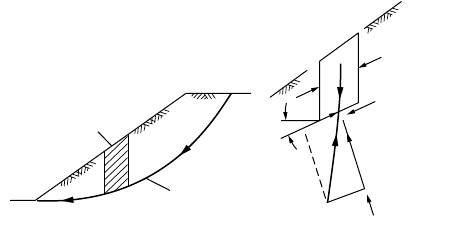
Stability of Slopes 21-5
programs are used routinely in virtually all geotechnical consulting offices. The following discussion is
intended to present the salient features of the assumptions and analytical approach used to perform the
stability analysis.
General
Failure, sudden or gradual, results when the mobilized stresses in a slope or its foundation equal the
available strength. Limit equilibrium analysis is the basis for most methods available for slope stability
evaluations. Consideration is given to a free body of the soil mass bounded by the slope and an assumed
“slip” or failure surface. The known or assumed forces acting on the body and the shearing resistance
required for stability are estimated. Most practical problems are statically indeterminate and require
simplifying assumptions regarding the position and direction of forces to render the problem determinate.
The primary assumption of the limit equilibrium method is that the assumed strength can be mobilized
throughout the length of the failure surface simultaneously. Strain compatibility is not considered. This
assumption is applicable for stress–strain conditions that can be modeled as perfectly plastic at the failure
strength. When soils have some post-peak strength reduction (as with most natural soil), engineering
judgment is required to select appropriate strength parameters and safety factors.
Two common free-body assumptions are illustrated in Fig. 21.2. In the cylindrical form shown in
Fig. 21.2(a), the mass weight W acting through lever arm E produces a driving moment. This moment
is resisted by strength S mobilized along the failure surface of length L that acts through a lever arm R. In
the simple wedge [Fig. 21.2(b)], strength S acting along the planar surface of length L resists the driving
forces resulting from gravity acting on weight W. A plane strain condition is assumed in most analytical
methods currently in use so the potential failure mass is analyzed per unit width. Resistance that would
be generated at the lateral extremities of the failure zone are considered insignificant compared to the
area of the potential failure surface. When three-dimensional analyses are performed, FS(3-D) > FS(2-D)
[Duncan, 1992] for most cases; therefore, two-dimensional analysis normally is conservative.
Common methods of analysis consider a system of forces. The soil mass is divided into a system of
“slices,” “blocks,” or “wedges,” and force and/or moment equilibrium conditions are evaluated for the
individual components of the soil mass. The soil strength is uniformly adjusted by a scaling factor until
the system is in a state of equilibrium. The actual soil strength divided by the strength required to satisfy
equilibrium is defined as the factor of safety.
Slices as Free Bodies
In modern force systems the sliding mass is divided into “slices” as shown in Fig. 21.3(a), which illustrates
a “finite” slope with a circular failure surface. The forces that act on a slice [Fig. 21.3(b)] include the
material weight W, normal force N, and shear force T distributed along an assumed failure surface; water
pressure force U; water pressure V acting in a tension crack; and forces E
r
, X
r
, E
L
, and X
L
acting along
FIGURE 21.3 Finite slope with cylindrical failure surface (a) and forces on an element (b).
Slice element
in slope
Failure
surface
(a) (b)
F
L
≠ F
R
q
F
L
F
R
W
N
T
U
S
P
© 2003 by CRC Press LLC
21-6 The Civil Engineering Handbook, Second Edition
the sides of the slice. A discussion of the treatment of tension cracks can be found in Tschebotarioff
[1973] and Spencer [1967]. Earthquakes impose dynamic forces in the form of the acceleration of gravity
acting on the mass component.
Planar Surfaces, Blocks, and Wedges
Simple planar failures involve a single surface which can define a wedge in soil or rock [Fig. 21.2(b)], a
sliding block, or a wedge in rock with a tension crack. The force system is similar to that given in Fig. 21.3,
except that the side forces are neglected. Complex planar failures involve a number of planes dividing
the mass into two or more blocks, and in addition to the force system for the single block, these solutions
provide for interblock forces.
Infinite Slope
The infinite slope pertains where the depth to a planar failure surface is small compared to its length,
which is considered as unlimited. Such conditions are found in slopes composed of the following:
•Cohesionless materials, such as clean sands
•Cohesive soils, such as residuum or colluvium, over a sloping rock surface at shallow depth
•OC fissured clays or clay shales with a uniformly deep, weathered zone
• Large slabs of sloping rock layers underlain by a weakness plane
Circular Failure Surfaces
General
In rotational slide failures, methods are available to analyze a circular or log-spiral failure surface, or a
surface of any general shape. The location of the critical failure surface is found by determining the lowest
value of safety factor obtained from a large number of assumed failure surface positions.
Slice Methods
Common to all slice methods is the assumption that the assumed soil mass and failure surface can be
divided into a finite number of slices. Equilibrium conditions are considered for all slices. The problem
is strongly indeterminate, requiring several basic assumptions regarding the location of application or
resultant directions of applied forces.
The slice methods can be divided into two groups: nonrigorous and rigorous. Nonrigorous methods
satisfy either force or moment equilibrium, whereas rigorous methods satisfy both force and moment
equilibrium. The factor of safety estimated from rigorous methods is relatively insensitive to the assump-
tions made to obtain determinacy [Duncan, 1992; Espinoza et al., 1992, 1994]. However, nonrigorous
solutions can produce significantly different estimates of safety depending on the assumptions made. In
general, a nonrigorous solution satisfying only moment equilibrium is superior to one satisfying only
force equilibrium and will provide solutions close to a rigorous method.
Ordinary Method of Slices
The ordinary method of slices, also known as the Swedish method, was developed by Fellenius [1936]
to analyze failures in homogeneous clays occurring along Swedish railways in the 1920s. The solution is
a trial-and-error technique that locates the critical failure surface, or that circle with the lowest value for
FS.
The ordinary method is not a rigorous solution because the shear and normal stresses and pore-water
pressures acting on the sides of the slice are not considered. In general the results are conservative. In
slopes with low f angles and moderate inclinations, FS may be 10 to 15% below the range of the more
exact solutions; with high f and slope inclination, FS can be underestimated by as much as 60%.
For the f = 0 case, normal stresses do not influence strength, and the ordinary method provides results
similar to rigorous methods [Johnson, 1974]. An example analysis using the ordinary method for the
f = 0 case as applied to an embankment over soft ground is given in Fig. 21.4.
© 2003 by CRC Press LLC
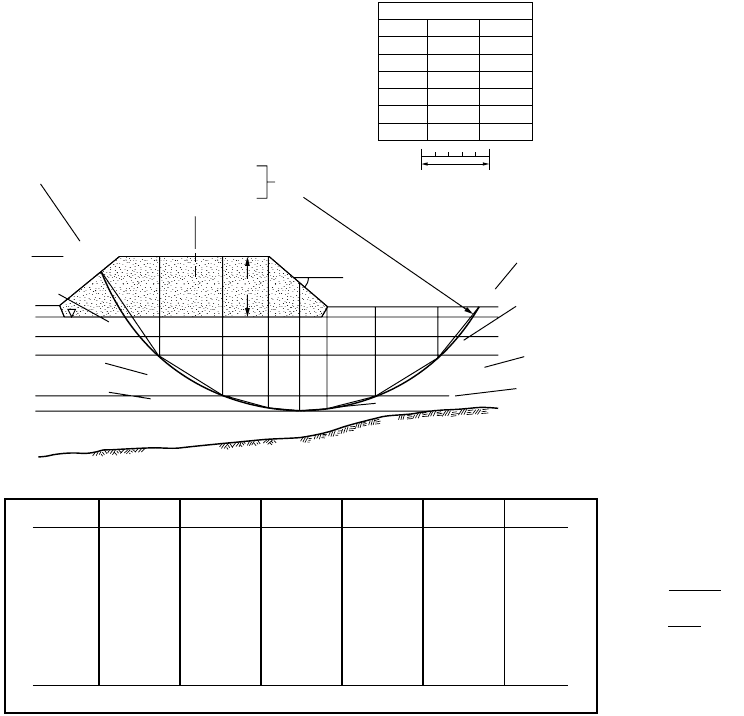
Stability of Slopes 21-7
A counterberm added to increase stability (Fig. 21.5) must be of adequate width to cause the critical
circle to pass beyond the toe with an acceptable value for FS.
Bishop Slice Methods
The rigorous Bishop method [Bishop, 1955] considers the complete system of forces acting on a slice,
as shown in Fig. 21.6. In addition to N¢
i
, U
i
, and T
i
, included along each side of the slice are shear stresses
(x
i
with width b
i
), effective normal stresses (E
i
), and pore-water pressures (U
L
and U
r
). In analysis,
distributions of (x
i
– x
i+1
) are found by successive approximation until a number of equilibrium conditions
are satisfied. Computations are considerable even with a computer.
The modified (simplified) Bishop method [Bishop, 1955; Janbu et al., 1956] is a simplification of the
rigorous method. In the modified method it is assumed that the total influence of the tangential forces
on the slice sides is small enough to be neglected.
Other Slice Methods
A number of other methods have been developed that differ in the statics employed to determine FS and
the assumptions used to render the problem determinate. Included are Spencer’s method [Spencer, 1967],
Janbu’s rigorous and simplified methods [Janbu et al., 1956], and the Morganstern–Price method
FIGURE 21.4 Embankment over soft clay: stability analysis for f = 0 case using ordinary method of slices. (Source:
Hunt, R. E. 1986. Geotechnical Engineering Techniques and Practices. McGraw-Hill, New York. Reprinted with per-
mission of McGraw-Hill Book Co.)
Note: For s
u
(fill)
s = σ
−
tan f = 22.5 × 0.119 × tan 25 = 1.2 ksf
Soil properties
Soil
Fill 0.119 1.2
1.2
1.2
0.8
0.6
0.8
0.119
0.119
0.117
0.117
0.123
Fine sand
Clay 1
Clay 2
Clay 3
Clay 4
g, kips/ft
3
Su,kips/ft
2
O
p
+
50 ft
40°
y = 86 ft
x = 22.5 ft
12
Fill
H=45 ft
3
r
4
5
6
+43
Fine sand
OC clay 1
OC clay 2
NC clay 3
NC clay 4 with sand lenses
Till
+2
−2
−14
−30
−60
−70
−112
2
7
7
8
8
6
5
3
4
1
El, ft
Peat
Peat
Slice
s
u
, ksf D
L
, ft
S
u
D
L
q, degrees
W
, kips*
W
sinq
1 1.2 76 91.2 56 203.39 168.62
2 0.8 58 46.4 32 359.73 190.63
3 0.6 34 20.4 17 399.74 116.87
4 0.6 24 14.4 5 187.15 16.31
5 0.6 21 12.6 −5 117.60 −10.25
6 0.6 39 23.4 −14 128.46 −31.08
7 0.8 58 46.4 −32 113.40 −60.09
8 1.2 42 50.4 −51 30.24 −23.50
L = 352 Σ = 305.2 Σ = 367.5
FS =
Σ
S
u
D
L
Σ
W
sin q
FS = = 0.83
305.2
367.5
© 2003 by CRC Press LLC
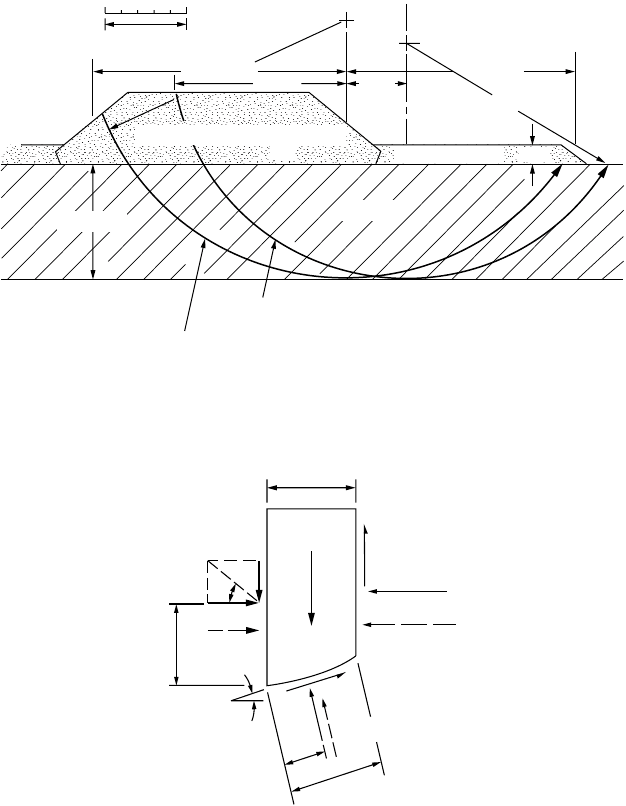
21-8 The Civil Engineering Handbook, Second Edition
[Morganstern and Price, 1965]. Espinoza et al. [1992, 1994] present a general framework to evaluate all
limit equilibrium methods of stability analysis and illustrate the variability among methods for circular
and irregular failure surfaces.
Chart Solutions for Homogeneous Slopes
Various chart solutions have been developed for simple homogeneous slopes, including Taylor [1937, 1948],
Janbu [1968], Hunter and Schuster [1968], and Cousins [1978]. They are useful for preliminary analysis of
the f = 0 case, and discussion and examples can be found in NAVFAC [1982] and Duncan et al. [1987].
Irregular and Planar Failure Surfaces
Geological conditions in many slopes are not amenable to circular failures, particularly when the potential
failure surface is shallow relative to its length. Several methods are suitable for analyses of these conditions,
FIGURE 21.5 Counterberm to provide stability for embankment shown in Fig. 21.3. FS = 1.2. (Source: Hunt, R. E.
1986. Geotechnical Engineering Techniques and Practices. McGraw-Hill, New York. Reprinted with permission of
McGraw-Hill Book Co.)
FIGURE 21.6 Complete force system acting on a slice. (Source: Lambe, T. W., and Whitman, R. V. 1969. Soil
Mechanics. John Wiley & Sons, New York. Used with permission of John Wiley & Sons, Inc.)
50 ft
O
p1
O
p
Counterberm
142 ft
r = 143 ft
Counterberm
New failure arc
Original failure arc
37 ft106 ft
b = 155 ft
Soft soils
D = 66 ft
P
1
= 0.119 × 45 = 5.36 kips/ft
Fill
P
2
= 134 kips/ft
12 ft
b
i
x
i
x
1
+ 1
U
r
d
i
a
i
U
i
= u
i
∆I
i
U
L
W
i
∆L
i
q
i
T
i
a
i
E
–
i
+ 1
E
–
i
N
–
i
© 2003 by CRC Press LLC
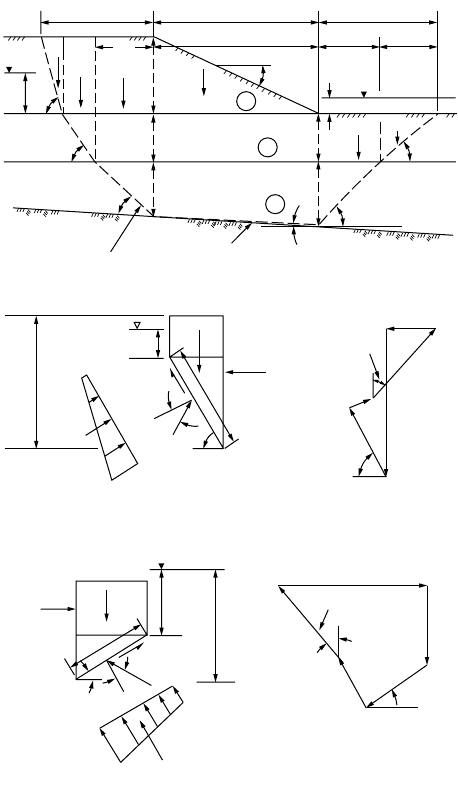
Stability of Slopes 21-9
including Spencer’s method [Spencer, 1967], the Morganstern–Price method [Morganstern and Price,
1965], and Janbu’s method [Janbu et al., 1956; Janbu, 1973].
In many natural situations the failure surface is planar and can be approximated by one or more
straight lines which divide the mass into wedges or blocks. Solutions for one-, two-, and three-block
problems are available in many sources, including Hunt [1986], Huang [1983], and NAVFAC [1982]. A
detailed discussion of the analysis of blocks as applied to rock slopes is given in Hoek and Bray [1977].
The translation failure method [NAVFAC, 1982] is based on earth pressures and is suitable for multiple
blocks, although interwedge forces are ignored. It is useful where soil conditions consist of several masses
with different parameters such as in the case illustrated in Fig. 21.7.
Three-dimensional or tetrahedral wedge failures are common in open-pit mines on heights of one or
two benches (60 to 100 ft) but become progressively less prevalent as slope height increases. Failure seems
to be associated with weakness planes that are of the same order of size as the slope height involved, with
FIGURE 21.7 Stability analysis of translational failure (a). The resultant horizontal force for a wedge sliding along
surface abcde is P
a
(b), and for sliding along surface efg is P
b
(c). (Source: NAVFAC. 1982. Design Manual, Soil
Mechanics, Foundations and Earth Structures, DM-7. Naval Facilities Engineering Command, Alexandria, VA.)
W
6
(a)
(b)
(c)
W
L
R
Active wedges Central wedge Passive wedges
b
4
b
3
W
2
W
3
W
4
W
5
f
c
B
f
1
, C
1
, g
1
f
2
, C
2
, g
2
f
3
, C
3
, g
3
,
h
1
h
2
h
2
h
3
h
4
P
W
b
1
−b
3
h
w
1
h
w
1
h
W1
h
W2
g
W
h
W2
P
W
W
R
R
W
L
h
W1
C
M
L
C
M
L
P
b
P
b
α − f
M
a
a
1
a
2
a
3
f
M
f
M
g
W
g
W
b + f /M
b
b
g
W
a
4
b
2
P
a
P
a
R
W
b
e
d
Potential
sliding surface
Firm base
i
b
5
b
6
g
2
3
1
α
α
h
W
1
P
W
P
W
C
M
L
h
W
1
C
M
L
h
W
2
h
W
2
© 2003 by CRC Press LLC
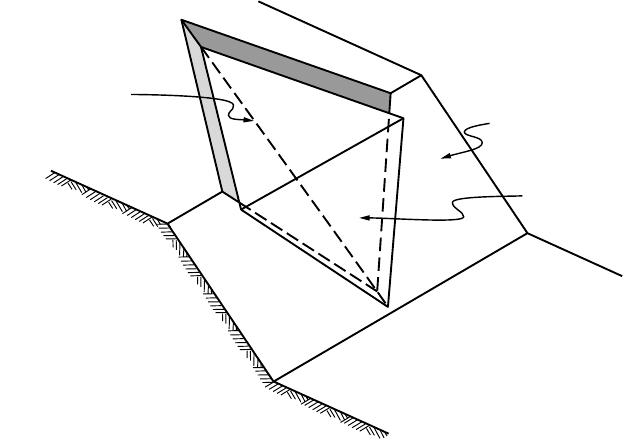
21-10 The Civil Engineering Handbook, Second Edition
the planes representing three or more intersecting joint sets. The “free blocks” approach tetrahedrons in
shape, as shown in Fig. 21.8. A discussion of the analysis of the tetrahedral wedge can be found in Hoek
and Bray [1977].
Earthquake Forces
Earthquake forces include cyclic loads which decrease the stability of a slope by increasing shear stresses,
pore air and water pressures, and decreasing soil strength. In the extreme case, increases in pore pressure
can lead to liquefaction. Sensitive clays and loose fine-grained granular soils above or below groundwater
level (GWL), and metastable soils such as loess even when dry, are very susceptible to failure during
cyclic loading. The presence of even a thin layer of saturated fine-grained soil, such as silt or clayey silt,
can lead quickly to instability in any slope. Embankments over fine-grained saturated soils are particularly
susceptible to failure, especially in areas where lateral restraint is limited.
Natural slopes composed of low-sensitivity clay, dense granular soils above or below GWL, or loose
coarse-grained soils below GWL generally are stable even during strong ground shaking. Earth-dam
embankments can withstand moderate to strong shaking when well-built to modern standards. The
greatest risk of damage or failure lies with dams constructed of saturated fine-grained cohesionless
materials. The general effect of ground shaking on embankments is slope bulging and crest settlement.
Pseudostatic Analysis
In the conventional approach, stability is determined as for static loading conditions and the effects of
an earthquake are accounted for by including an equivalent horizontal force acting on the mass. The
horizontal force, as shown in Fig. 21.9, is expressed as the product of the weight and a seismic coefficient k,
which is related to induced accelerations. The effects on pore pressure are not considered, and a decrease
in soil strength is accounted for only indirectly. Hall and Newmark [1977] developed design accelerations
for horizontal ground motion for slope stability studies as related to magnitude, as given in Table 21.3.
Augello et al. [1994] provide additional guidance for selecting appropriate design accelerations.
FIGURE 21.8 Geometry of a triangular wedge failure. (Source: Hoek, E., and Bray, J. W. 1977. Rock Slope Engineering,
2nd ed. The Institute of Mining and Metallurgy, London.)
Line of intersection
Slope face
Wedge
© 2003 by CRC Press LLC
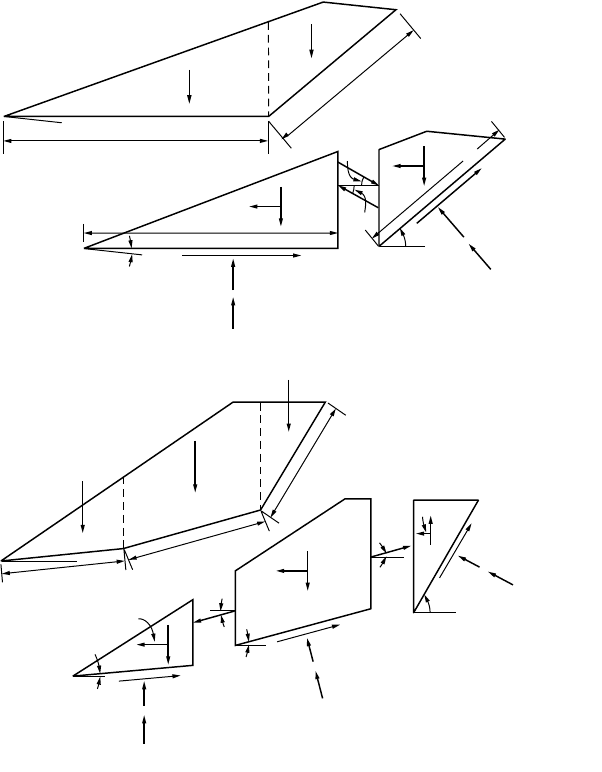
Stability of Slopes 21-11
Time–History Dependence
Pseudostatic analysis is based on peak accelerations producing dynamic inertial forces. They may be
sufficiently large to drop FS below unity for brief intervals during which displacements occur, but
movement ceases when accelerations drop. The time element of the dynamic loadings is extremely
significant and is not typically considered in analysis. Augello et al. [1995] and Bray et al. [1995] evaluate
the time–history-dependent movements associated with stability of landfill slopes.
If dynamic loads are applied in cycles with small periods, but relatively long duration, soil will not
have time to drain between loadings, pore pressures will continue to increase, and failure by liquefaction
may occur. The Alaskan event of 1964 lasted almost three minutes, causing disastrous slides at Turnagain
Heights where previous earthquakes of equal magnitude but shorter duration had caused little damage.
Dynamic Analysis
Dynamic analysis of embankments is performed employing finite element methods [Newmark, 1965;
Seed, 1966; Seed et al., 1975; Byrne, 1991; Finn, 1993]. Embankment response to base excitation is
FIGURE 21.9 Complex wedge systems: (a) free-body diagrams for two blocks and (b) free-body diagrams for three
blocks. (Source: After Huang, Y. H. 1983. Stability Analysis of Earth Slopes. Van Nostrand-Reinhold, New York.)
(a)
(b)
r
u
W
1
cos q
1
r
u
W cos q
3
r
u
W
2
cos q
2
N
_
1
N
_
3
N
_
2
q
1
f
d
q
d
q
3
W
2
W
3
W
1
W
1
P
1
P
2
W
2
W
3
kW
2
kW
3
T
kW
1
L
1
L
1
L
3
L
2
T
3
L
3
T
2
L
2
q
1
q
2
L
1
r
u
1
r
u
2
c
1
L
1
+ (N
_
1
− r
u
1
) tg f
c
1
L
2
+ (N
_
2
− r
u
2
) tg f
N
_
2
f
d
f
d
f
d
= tg
−1
(tg f /FS)
N
_
1
W
2
W
1
L
1
L
2
kW
1
W
1
P
1
P
2
kW
2
W
2
L
2
q
2
© 2003 by CRC Press LLC
